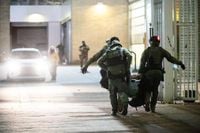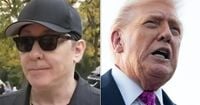Federal immigration enforcement in Chicago has erupted into a high-profile legal and political battle, drawing in federal judges, city officials, and the White House. On October 20, 2025, federal agents from U.S. Immigration and Customs Enforcement (ICE) and Customs and Border Protection (CBP) appeared before U.S. District Judge Sara Ellis in Chicago to answer for their actions during a recent immigration crackdown that has sparked widespread controversy and concern, according to ABC7 Chicago.
The hearing was prompted by two recent arrests on Chicago’s Southeast Side, incidents that escalated into large public gatherings and saw federal agents deploy tear gas. Judge Ellis, expressing what she called “deep concern” over the conduct of federal agents, summoned leadership from both ICE and CBP to testify about the events and the broader federal operation, known as “Operation Midway Blitz.”
Customs and Border Protection Deputy Incident Commander Kyle Harvick, one of the federal government’s designated witnesses, offered detailed testimony. As reported by ABC7 Chicago, Harvick stated that all agents working under Operation Midway Blitz have been assigned body-worn cameras. In the Chicago area alone, there are 201 Border Patrol agents, not including ICE personnel. Harvick emphasized that CBP officers are required to keep their cameras on and recording during all enforcement activities, a policy that has been reinforced through electronic communication and daily roll-call meetings in light of a temporary restraining order (TRO) issued by Judge Ellis.
Harvick explained the agency’s rationale for deploying tear gas on two separate occasions. On October 12 in Albany Park, body-camera footage reviewed by Harvick showed that after an arrest, members of the public linked arms and surrounded agents, preventing them from leaving the scene. A supervisor on site determined that tear gas was necessary to disperse the crowd. In the second incident, on October 14 on the Southeast Side, Harvick testified that he did not personally review body-camera footage but was told that warnings were issued before tear gas was deployed. In this case, officers reportedly responded to objects—including an egg, a brick, and a metal object—being thrown in their direction.
Judge Ellis pressed Harvick on the training and identification practices of CBP agents. According to his testimony, all agents receive quarterly training on use-of-force, and while some have more advanced crowd control training, there was no specific preparation for the Chicago deployment. Ellis also questioned the use of face and head coverings by agents during enforcement activities. Harvick acknowledged that while some wear them for cold weather or protection from gases, the primary reason is to guard against doxxing—where agents or their families might be targeted or harassed if identified. In accordance with the TRO, all CBP agents must now display an identifying number on their uniforms, sometimes using duct tape on their shoulders if necessary.
The legal scrutiny comes amid a broader national debate over the use of federal force in American cities. On October 17, 2025, President Donald Trump filed an emergency appeal to the Supreme Court, seeking permission to deploy National Guard troops to Chicago after two lower courts denied the request, Axios reported. The city and state faced a deadline on October 20 to respond to the Trump administration’s appeal. Legal experts told ABC News that if the Supreme Court were to take up the case and rule in Trump’s favor, National Guard troops could be deployed to Chicago within a month.
This push for federal military intervention is not isolated to Chicago. As detailed by Bloomberg and Hindustan Times, President Trump has threatened to send troops to other Democratic-controlled cities, most recently San Francisco. In an interview aired on October 19, Trump said, “Next we’re going to go to San Francisco. The difference is, I think they want us in San Francisco. San Francisco was truly one of the great cities of the world. And then 15 years ago, it went wrong. We’re going to go to San Francisco and we’re going to make it great.”
Trump’s strategy of deploying the National Guard has already seen troops sent to Los Angeles, Washington, and Memphis, often over the objections of local leaders. Judges, however, have halted similar deployments in Chicago and Portland. The president has justified these actions by pointing to what he calls urban decline and lawlessness, though critics—including many city and state officials—argue that such measures are politically motivated and inflame tensions rather than resolve them.
The debate over federal intervention has even roiled the city’s own agencies. WTTW reported that Chicago’s interim ICE field office director, Russell Hott, returned to Washington, D.C., just days before he was scheduled to appear before Judge Ellis to explain recent federal immigration actions. This sudden departure has fueled speculation about internal disagreements and the pressures facing federal officials in the current climate.
Chicago’s legal and political establishment remains deeply divided. While Judge Ellis has taken steps to limit the use of force and enhance accountability—ordering agents not to use tear gas on peaceful protesters without warning and mandating body-camera use—others are bracing for further escalation. ABC7 Chicago Chief Legal Analyst Gil Soffer commented, “It could be quite interesting because the judge is going to get into some nitty gritty about what exactly ICE is doing to comply with the order.”
Meanwhile, the city’s residents and advocacy groups have voiced strong opinions on both sides. Some community members have protested what they see as heavy-handed tactics, particularly the use of tear gas in densely populated neighborhoods. Others, often citing concerns about crime and public safety, have called for stronger enforcement and even supported the idea of National Guard intervention.
The national political context is impossible to ignore. Trump’s comments about using cities as “training grounds” for the military and his repeated references to urban decline in Democratic-led cities have become a flashpoint for partisan debate. San Francisco, in particular, has become a symbol in right-leaning media of what they claim is the failure of progressive urban governance, especially regarding homelessness and drug addiction. The city’s challenges have even divided the tech community, with Salesforce CEO Marc Benioff’s brief support for military intervention sparking backlash and public debate about the proper role of federal force in local affairs.
For now, the fate of Chicago’s streets—and the broader question of federal intervention in American cities—hangs in the balance. The Supreme Court’s decision on the Trump administration’s emergency appeal could set a precedent for how far the federal government can go in deploying military force within U.S. borders, particularly in defiance of local and state leaders. As the legal wrangling continues, city officials, federal agents, and residents alike are bracing for whatever comes next in this high-stakes showdown.
In a city known for its resilience and political activism, the coming weeks promise to test both the limits of federal authority and the resolve of Chicago’s communities.

